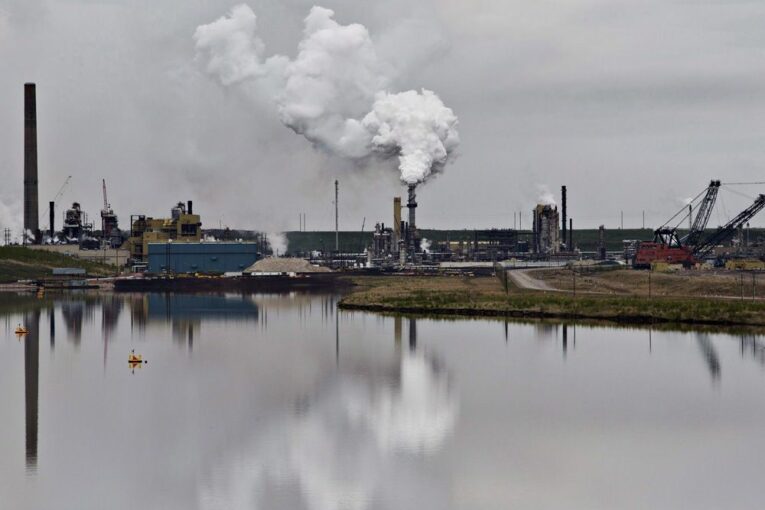
CALGARY — Ottawa is committing to stricter methane reduction targets for the oil industry ahead of COP 26, the international climate change conference in Glasgow this month, but the federal government and the oilpatch in Calgary are locked in a debate on how to measure methane emissions.
In their 2021 election campaign, the Liberals promised to reduce oil and gas sector industry’s methane emissions 75 per cent below 2012 levels by 2030 — a much more stringent target than the current 45 per cent reduction by 2025.
Environment and Climate Change Minister Jonathan Wilkinson said Monday the country would commit to the Global Methane Pledge to cut methane emissions 30 per cent below 2020 levels and announced a commitment to meet a goal set by the International Energy Agency to cut 75 per cent of oil and gas methane emissions, making Canada the first country to commit to both targets.
But Ottawa and the energy industry are still debating how to measure methane emissions, which have an 80 times greater greenhouse gas effect than carbon dioxide over 25 years in the atmosphere. Academics and environmental groups say current federal data only accounts for about half of the country’s methane emissions.
Energy industry executives say discussions with Ottawa on methane measurements are not politically charged, though they are expecting new methane commitments before the 26th United Nations’ Conference of the Parties (COP26) global climate change conference in Glasgow starting Oct. 31.
“It’s very technical. The federal government obviously wants to make sure that it’s correctly being calculated, which I can appreciate,” said Tristan Goodman, president of the Explorers and Producers Association of Canada, which represents small- and mid-sized oil and gas companies.
The crux of the issue is measuring how much methane is released into the atmosphere when natural gas is flared or combusted, and how much of that methane is turned into CO2. There are also discussions about how much methane escapes from pneumatic devices and other equipment.
Goodman said calculating how much methane is released into the atmosphere from flaring and combustion has been an ongoing scientific debate and there are different formulas that can lead to slightly different conclusions.
He said the industry does not interpret the debate about measurements as a way to force new targets on the oilpatch.
“I don’t think there’s some other component that this is someway to further reduce emissions without changing the requirements. I don’t think that’s what they’re getting at. I think they’re trying to make this as accurate as possible,” Goodman said.
On the other hand, the oil and gas industry is expecting Ottawa to “further tighten” methane emissions targets heading to Glasgow on Oct. 31.
The federal government previously updated its method for measuring methane emissions as reported in its National Inventory Report and “further improvements will be in our next NIR with respect to fugitive methane emissions from upstream oil and gas,” said Joanna Sivasankaran, press secretary to Minister Wilkinson.
“These methods use Canadian-specific studies and knowledge, facilitate the adoption of new scientific data, and better capture the impact of improvements in technologies and industry practices on emissions,” Sivasankaran said, adding that methane is responsible for 13 per cent of Canada’s total greenhouse gas emissions.
New academic studies show that methane emissions are coming from a broader range of sources than previously thought, including lit and unlit flares, said Jan Gorski, senior analyst at the Pembina Institute.
“We need to carefully re-examine whether the rules and regulations that we have in place right now are going to meet the targets that were set and the federal government is right now conducting a progress review to see if they’re on track to meet their 2025 targets,” Gorski said, adding, “it’s important this new data gets factored in.”
A July 2021 study conducted by two Carleton University professors for the American Chemical Society on oil and natural gas facilities in British Columbia found wells in the province emitted roughly twice the methane recorded by federal inventories.
Professors Matthew Johnson and David Tyner used a combination of aerial and ground monitoring of 167 sites, including 105 wells, accounting for 96 per cent of upstream B.C. methane emissions and found emissions were between 1.6 times and 2.2 times higher than federal inventories.
“Nearly three quarters of emissions are attributed to four main sources: production tanks (24 per cent), pneumatic devices (20 per cent), reciprocating compressors (15 per cent) and unlit flares (13 per cent),” the authors wrote, adding future policy should focus on these sources to achieve meaningful reductions.
The industry is bracing for the new regulations in the hope of getting more regulatory clarity.
“Canada’s natural gas and oil industry is the country’s leading investor in emissions reduction and clean technology,” said Jay Averill, spokesperson for the Canadian Association of Petroleum Producers, which represents the country’s largest oil and gas companies, adding the industry “is already a leader in methane reduction technologies and practices.”
“Companies also have a financial interest in these efforts as each methane molecule captured means less emissions and more product makes it to market,” Averill said.
• Email: [email protected] | Twitter: geoffreymorgan
You can read more of the news on source
